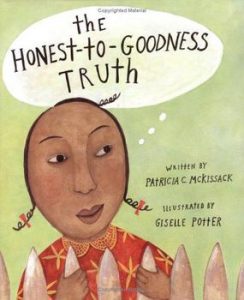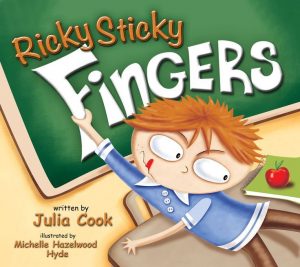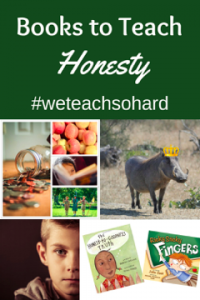
With so much dishonesty in our world today, us gals from We Teach So Hard have decided to dedicate this month’s book chat to the subject of honesty. I’m going to share two wonderful read alouds that I came across and I know you’ll love them as much as I do. They’ll be a welcome addition to your classroom library.
First I’d like to share The Honest to Goodness Truth by Patricia McKissack, illustrated by Giselle Potter which is a wonderful story about Libby who promises her mother that she’ll always tell the truth no matter what! But, is  honesty really the best policy? and If it is, then why is everyone so mad at her? You see, when Libby started telling the truth, the trouble began. One day at school, she embarrassed her BFF Ruthie Mae when she publicly told , her that she had a hole in her sock, and Ruthie Mae got very angry. Next she tattled on Willie when she told the teacher that he didn’t do his homework and he gave her a nasty look. Finally she told a neighbor that her yard was messy. Libby had pushed honesty to the limit in and outside of school alienating others as she realized that being honest isn’t so simple. After talking to mom, she understood that telling the truth is important, but there’s a right and a wrong way to do it. Kids will sympathize with Libby’s struggles and will be eager to discuss this topic.
honesty really the best policy? and If it is, then why is everyone so mad at her? You see, when Libby started telling the truth, the trouble began. One day at school, she embarrassed her BFF Ruthie Mae when she publicly told , her that she had a hole in her sock, and Ruthie Mae got very angry. Next she tattled on Willie when she told the teacher that he didn’t do his homework and he gave her a nasty look. Finally she told a neighbor that her yard was messy. Libby had pushed honesty to the limit in and outside of school alienating others as she realized that being honest isn’t so simple. After talking to mom, she understood that telling the truth is important, but there’s a right and a wrong way to do it. Kids will sympathize with Libby’s struggles and will be eager to discuss this topic.
Here are some questions you can use with your students when discussing this book
After Libby is punished for lying to her mother, she emphatically decides “From now on, only the truth.”
- Should Libby have promised to always tell the truth? Explain your answer.
- If Libby didn’t get caught lying about feeding the old horse do you think she’d keep lying?
- Is telling a lie only wrong if you get caught? Explain your answer
- Would it be alright to lie if there were no consequences? Why or why not
- Why were Libby’s school friends angry with her?
- Do you suppose that the only reason Libby changed her truth telling was because her friends were mad at her, or should she have known better?
- What problems does being too truthful cause? Can it be harmful? Why or why not
- Is it important to tell the truth even if it’s mean or hurtful?
- If the truth hurts, should it be watered down? Explain
- If the truth is watered down, does it become a lie? Explain
- Was it right for Libby to tell the teacher that Willie didn’t do his homework? Explain
- Libby tattled on Willie, is there a difference between being honest and tattling? Explain
- What does Libby’s mother means by the above quote?
- What is meant by honest-to-goodness truth?
- Libby had a hard time understanding what her mother meant, would it be hard for you too?
- Was it important for Libby to experience a painful truth to understand why everyone was mad at her? Explain
This book opens itself up to great role plays. You or your collaborative groups could write scenarios, based on the above questions, or anything else that’s appropriate, and have them present them to the class.
Ricky Sticky Fingers by Julia Cook, illustrated by Michelle Hazelwood Hyde, is a read aloud book employing empathy to teach children that stealing is dishonest and wrong. It’s a story about a young boy who steals things. If you have students in your classroom with “sticky fingers,” this is what you’ve been looking for. Ricky is a young boy who just can’t help himself from stealing, if he sees something he wants he just takes it because things stick to his fingers like a wad of irresistible bubble gum, or some goop that you can throw on the wall and watch it ooze down to the floor. He just doesn’t realize that stealing is wrong. He learns a lesson when his bicycle is missing and he finally understands what it’s like to have something stolen from him. He realizes that we all have bad and good inside of us. He lets the good take over the bad and returns all the items he stole. This helps him feel good inside and  he likes that feeling.
he likes that feeling.
- Before reading this book, let the class know that this book is about a boy with sticky fingers. Discuss what is meant by sticky fingers.
- Then tell them that the story has a moral. Ask what a moral is. Discuss books they’ve read that have a moral.
After the story has been read, ask the following questions:
- Is it ever alright to steal? Explain
- Why did Ricky steal?
- What kind of trouble did Ricky’s sticky fingers get him into?
- After Ricky’s mom discovered the gum and wall goop, what did Ricky say when she asked him how he got these things. Do you think he felt uncomfortable by not being honest with his mother?
- What was the turning point in the story? Explain
- What was the lesson learned/moral?
- What would you do if you saw someone take something from the teacher’s desk or another child’s desk?
Have the class work in collaborative groups, or individually to write a story about someone who was dishonest and include a moral or lesson learned. Another idea would be to have them draw and label a comic strip about dishonesty and the lesson the character learned.
Click on the image or a link to our podcast.
You don’t want to miss reading the rest of the blog posts from my BFF at We Teach So Hard. Just click the image below.

Clockwise, from top left:
Honesty Themed Books for Your Readers by Mossy Oak Musings
Books to Teach Honesty by Tried and True Teaching Tools
Honesty by Rainbow City Learning
Is Honesty the Best Policy by Socrates Lantern


Deann, I found these titles in my library and they’ll round out my mini-theme study on honesty. I especially like the first one, because it explores the social norms of telling white lies, etc. Can’t wait to use these! Thank you!
I need to get The Honest to Goodness Truth! It’s such a great conversation to have with students! Thanks for all the questions and ideas!